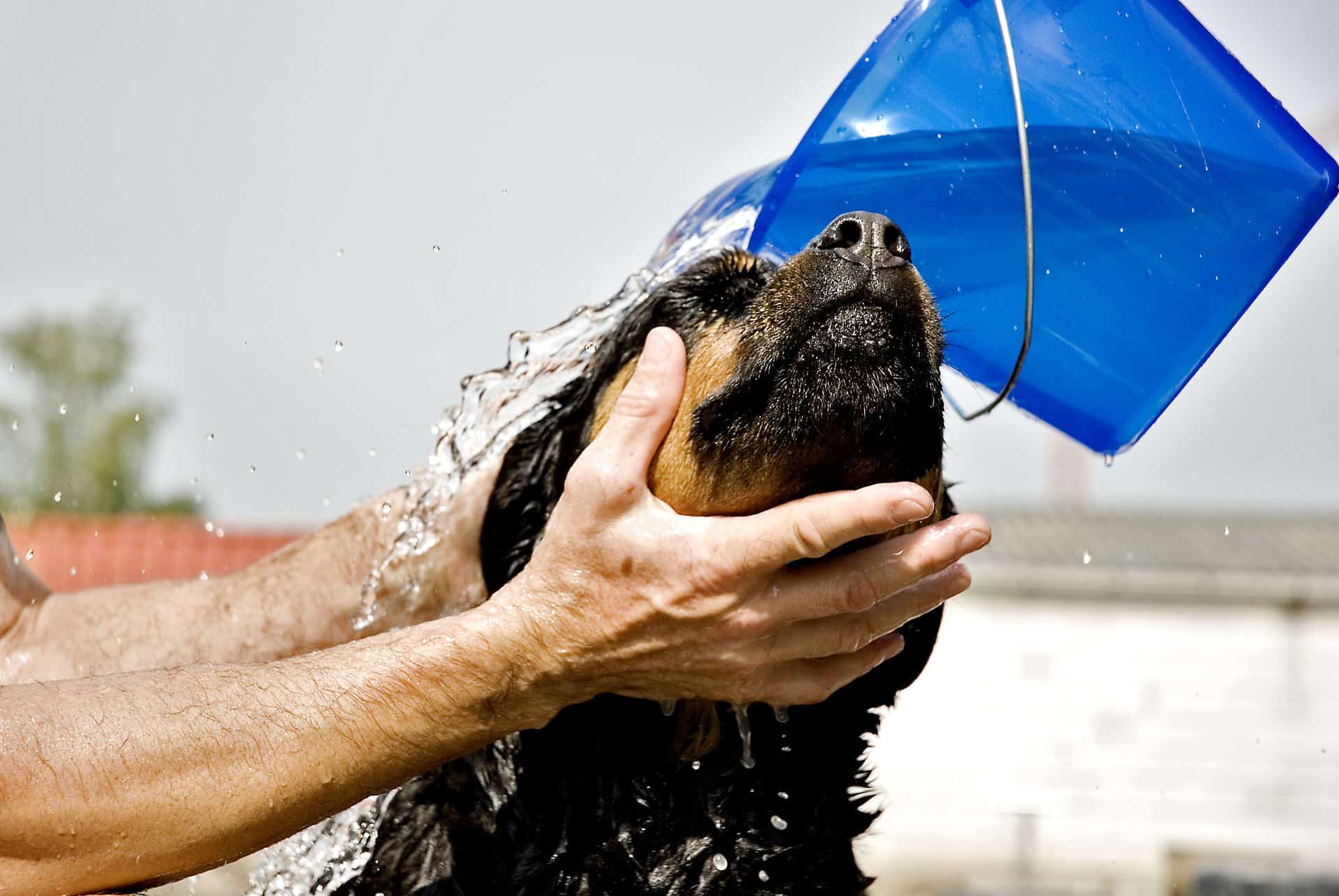The Many Benefits of Giving Your Dog a Bath
Posted by Lora Shaw on March 22, 2022
Bathtime with Your Pup: Key Takeaways
- Regular bathing helps maintain your dog’s skin and fur by removing dirt, oils, and allergens that can accumulate over time. This practice not only keeps their fur clean and fresh but also prevents skin irritations and conditions.
- Bathing your pup regularly can significantly reduce shedding, which helps keep your home cleaner and benefits individuals who are sensitive or allergic to pets.
- Bath time serves as an excellent bonding experience between you and your dog, as it allows for one-on-one interactions that can strengthen trust.
The benefits of a dog bath go far beyond keeping their fur soft and clean. Just like humans, a dog’s skin and coat will experience a buildup of dirt and oils over time. Keeping your dog on a regular bathing schedule will ensure that they are maintaining a healthy coat, and, as a result, keeping your shared spaces free from excess pet dander.
In today’s post, we at Pet Palace have broken down some of the most important reasons why routine dog baths should be a no-brainer.
Benefits of a Dog Bath: Everyone Loves a Clean Dog!
Removes Dirt and Odor
Take a moment to think about all the ways your dog likes to play – running through the backyard, rummaging around with sticks, greeting other dogs on walks, and more. After so much time going about their day-to-day routines, dogs will start to stink! Not only this, but their skin and coat will naturally accumulate dirt from these everyday activities.
Bathing your dog on a regular basis will help to keep their coats smelling fresh and their skin looking and feeling clean and healthy – some of the many benefits of giving your dog a bath.
Improves Skin and Coat Health
In addition to bathing your dog routinely to remove dirt and odor, you should also be aware of the positive impact it can have on their skin coat and health. Too much buildup of one thing or another can cause irritation of your dog’s skin, leading to rashes and/or lesions.
Typically, dog baths are followed up by a thorough brushing, which also helps prevent fur matting, inflammation, and overall discomfort for your dog.
Helps Keep You Informed on Your Dog’s Well-being
Lastly, our dogs have limited means of communication, which is a major reason why becoming familiar with their skin, coat, ears, teeth, nails, and tails is very important to helping them maintain good health.
By making sure your dog is bathed on a regular basis, you’ll ensure you have a happy, healthy pup, free from potential illnesses that may present themselves externally.
Reduces Shedding and Airborne Allergens
If there’s one thing we as dog owners all wish for, it would be to have all of the pet cuddles and none of the loose fur they leave behind. The good news is, one of the many dog bathing benefits is that you can significantly reduce your dog’s shedding by regularly bathing and brushing their coats.
Less shedding means that your home is less likely to irritate those who are sensitive or allergic to pet dander, and it also just helps keep your home clean and orderly. It’s a win-win scenario for all parties involved!
Builds Bonds and Maintains Trust
Most one-on-one activities with your pet are a great way to build bonds and establish and maintain trust, and dog baths are not the exception! For dogs who love the water and lots of pets, bath time will feel like a reward.
Contrarily, for dogs who are more reluctant to settling down for bath time, it is a great opportunity to practice patience and make them feel loved and safe. You can also consult with your local pet groomer to book a reservation for your dog’s bath time!
Tips for Giving a Small Dog a Bath
Compared to large dogs, small dogs are fairly easy to bathe since they are generally easier to control and are so much lighter. However, some small dogs can be very excitable, squirmy, and prone to panicking, so there are some general tips you’ll want to follow to make sure the bathing process goes smoothly.
- Prepare your materials in advance so you won’t be searching during the bath
- Pick a location for the bath – thankfully, due to your dog’s size, you will have many options to choose from, including the bathtub, sink, or an outdoor plastic container
- As you go, try to make the process fun and interactive for your dog, possibly by incorporating treats as rewards
- Prep your dog by getting them used to the water, as well as clipping and grooming them to take care of any troublesome tangles
- Use a showerhead or hose to gently wet your pet and then begin to calmly work in shampoo
- Check for any abrasions or skin problems as you go and make note of anything concerning to tell your vet
- Rinse your dog gently and clean their ears with a cotton ball and brush their teeth if you think they are due, then towel dry and you’re good to go!
Tips for Giving Large Dogs a Bath
Generally, the tips you would follow for bathing a large dog would be very similar to those for bathing a small dog, as outlined above. However, due to your dog’s size, certain complications can arise and different methods will need to be employed. Here are some key tips to keep in mind:
- Depending on the size and weight of your dog, you may want a larger and/or stronger member of your household to handle washing duties, or you might find that bathing is best approached as a two-person operation
- Determine your bathing location, which could be either a bathtub or a plastic container outside, or even just within your yard if it works best for your situation and pet
- Consider leashing your dog during the bath if you’re concerned about them running off midway through
- Follow the general bathing tips we covered in the previous section and you’ll be all set!
How to Get Your Dog in the Bathtub
Giving your dog a bath requires at least some level of cooperation from your pet, so to ensure you get that you’ll want to have some strategies in mind. We recommend:
- Using treats – The great motivator, right? While you don’t want to dilute the power of treats by giving them too often, or pack the pounds onto your pup, using treats judiciously during bathtime can go a long way in making everything go smoothly.
- Making a game of it – As long as everything is done safely and surfaces are dry, you could make a game out of getting in the tub by having your pet jump or step in and out of the tub to chase after treats. Once they are used to the action, getting in for the bath itself won’t be a big deal and they’ll associate it with positive emotions.
- Trying peanut butter – Taking the treat possibility to another level, you could even put a bit of peanut butter on the side of your bathtub and guide your dog to it. With them inside the tub and distracted by the special treat, you’ll be able to get down to work.
- Using a rubber mat – Nobody wants their dog slipping and sliding within the bath because that can easily lead to injury, so investing in a non-slip rubber bathmat for the inside of your tub is encouraged.
- Minimizing the water level – To further prevent slipping, and avoid upsetting your dog, keeping the water level low initially is a good idea. This way your dog can get inside the tub and get used to things, and you can always add more water as needed as you go.
Tips for Bathing an Uncooperative Dog
Not every dog loves getting a bath, even if they desperately need one. Along with the standard approach of bribing them with treats, here are some other options to get them to cooperate.
- Prepare all your equipment in advance to keep things moving and not give your dog time to bolt during distracted moments
- Use a gentle shampoo that won’t hurt your dog’s eyes or skin
- Use warm water rather than hot or cold, since both latter options can be a shock to your dog’s system
- Create a positive environment complete with treats, toys, and affirmations
- Have a helper on hand to make things go faster, assist you, and keep your dog calm
Dog Bathing FAQs
Why are dogs so crazy after a bath?
After you bathe your dog, you may notice them being more hyper or active, which is normal. Dogs traditionally shake off excess water following baths or after being caught in the rain, but they also need to carefully regulate their body heat since they cannot sweat. If the water used was particularly hot, they may be trying to remove it to cool down, while if it was on the cold side, they may be trying to remove it so they can warm up. They might also simply become more active due to relief or happiness.
How often should I give my dog a bath? Can you bathe dogs every day?
Most experts recommend bathing your dog every one to three months in an effort to keep them smelling clean, looking their best, and minimizing oily buildup. Recommendations can vary somewhat, however, based on breed, the dog’s coat type, activity levels, and any skin problems, so you may want to consult with your veterinarian.
Bathing a dog every day, in addition to being incredibly time consuming, would not actually be the best thing for your dog. This is because excessive bathing (giving them baths more than once a week) can lead to dried out skin and coats, which can lead to additional problems.
When should I give my dog a bath?
Going along with the answers above, you should work off of the one-to-three-month standard and possibly discuss best practices with your vet. Keeping track of a bathing schedule would be a good idea so you don’t overdo or underdo it, and obviously if your pet gets particularly dirty during some activity you might want to increase frequency or change your pattern.
Do dogs understand baths?
Some dogs love baths (and water in general), while others are very averse to the entire experience, so each dog definitely understands what baths mean to them. As far as dogs understanding the greater purpose of baths, that’s hard to determine, but having less dirt, grime, odors, and matting following a bath would definitely be noticeable, so some dogs likely associate these positive changes with the bathing process.
Do dogs feel clean after a bath?
Yes, most dogs feel better following baths. There are some exceptions, such as with dogs who have had negative, traumatic experiences with baths, but in general most dogs tend to show positive responses to getting a bath and being clean.
Schedule Your Next Dog Bath with Pet Palace!
With these advantages, it’s clear that getting your pup on a routine bathing schedule is beneficial for you and them. We understand that life gets crazy sometimes, though, and you aren’t always able to make time to bathe your dog yourself. This is why we offer a full-service pet spa where your dog can get pampered by one of our dog-loving team members.
Visit our dog grooming services page today to learn more and contact us to book an appointment!

Categories: All Posts, Dogs, Pet Grooming, Tips for Your Pets
Archives
Recent Articles
Categories
Monthly Archive
- August 2025
- July 2025
- June 2025
- May 2025
- April 2025
- March 2025
- February 2025
- January 2025
- December 2024
- November 2024
- October 2024
- September 2024
- August 2024
- July 2024
- June 2024
- May 2024
- April 2024
- March 2024
- February 2024
- January 2024
- December 2023
- November 2023
- October 2023
- August 2023
- July 2023
- June 2023
- May 2023
- April 2023
- March 2023
- February 2023
- January 2023
- December 2022
- November 2022
- October 2022
- August 2022
- July 2022
- June 2022
- April 2022
- March 2022
- February 2022
- November 2021
- October 2021
- November 2020
- September 2020
- July 2020
- March 2020
- January 2020
- November 2019
- September 2019
- July 2019
- March 2019
- January 2019
- December 2018
- November 2018
- October 2018
- August 2018
- July 2018
- June 2018
- May 2018
- April 2018
- March 2018
- February 2018
- January 2018
- December 2017
- November 2017
- October 2017
- September 2017
- August 2017
- July 2017
- June 2017
- May 2017
- April 2017
- March 2017
- February 2017
- January 2017
- December 2016
- November 2016
- September 2016
- August 2016
- July 2016
- June 2016
- May 2016
- April 2016
- March 2016
- February 2016
- December 2015
- November 2015
- October 2015
- September 2015
- August 2015
- July 2015
- May 2015
- March 2015
- February 2015
- January 2015
- December 2014
- November 2014
- September 2014
- August 2014
- July 2014
- June 2014
- May 2014
- March 2014
- February 2014
- January 2014
- December 2013
- November 2013
- October 2013
- September 2013
- August 2013
- June 2013
- May 2013
- March 2013

